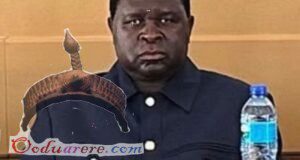When Sékou Touré of Guinea decided in 1958 to get out of french colonial empire, and opted for the country independence, the french colonial elite in Paris got so furious, and in a historic act of fury the french administration in Guinea destroyed everything in the country which represented what they called the benefits from french colonization.
Three thousand French left the country, taking all their property and destroying anything that which could not be moved: schools, nurseries, public administration buildings were crumbled; cars, books, medicine, research institute instruments, tractors were crushed and sabotaged; horses, cows in the farms were killed, and food in warehouses were burned or poisoned.
The purpose of this outrageous act was to send a clear message to all other colonies that the consequences for rejecting France would be very high.
Slowly fear spread trough the african elite, and none after the Guinea events ever found the courage to follow the example of Sékou Touré, whose slogan was “We prefer freedom in poverty to opulence in slavery.” Sylvanus Olympio, the first president of the Republic of Togo, a tiny country in west Africa, found a middle ground solution with the French.
He didn’t want his country to continue to be a french dominion, therefore he refused to sign the colonisation continuation pact De Gaule proposed, but agree to pay an annual debt to France for the so called benefits Togo got from french colonization.
It was the only conditions for the French not to destroy the country before leaving. However, the amount estimated by France was so big that the reimbursement of the so called “colonial debt” was close to 40% of the country budget in 1963.
The financial situation of the newly independent Togo was very unstable, so in order to get out the situation, Olympio decided to get out the french colonial money FCFA (the Franc), France educational system, military and commercial preferences.
Below are the 11 main components of the Colonisation continuation pact since 1950s:
 Ọmọ Oòduà Naija Gist | News From Nigeria | Entertainment gist Nigeria|Networking|News.. Visit for Nigeria breaking news , Nigerian Movies , Naija music , Jobs In Nigeria , Naija News , Nollywood, Gist and more
Ọmọ Oòduà Naija Gist | News From Nigeria | Entertainment gist Nigeria|Networking|News.. Visit for Nigeria breaking news , Nigerian Movies , Naija music , Jobs In Nigeria , Naija News , Nollywood, Gist and more









